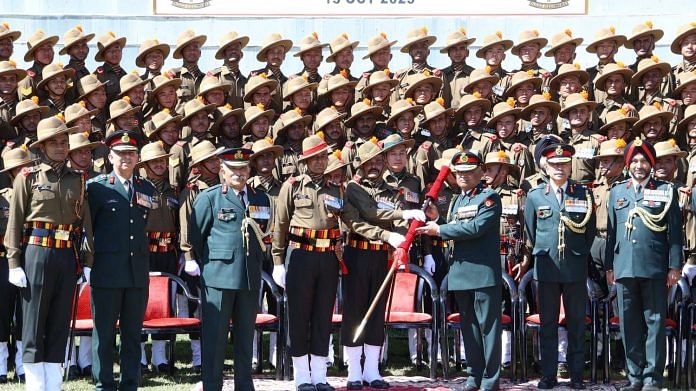New Delhi: The 3rd Battalion of the Naga Regiment (3 Naga) Friday got the President’s Colour award from Army chief Gen. Manoj Pande, heralding a new phase for the unit that has already bagged several citations.
The ‘colour’ — represented by a flag — was presented to the battalion at the Kumaon Regimental Centre (KRC) in Ranikhet.
Also called ‘Nishan’, presidential colours are a military tradition, and seen as the recognition of a battalion’s feats.
‘Colour’ symbolises the collective spirit of the battalion, and “its acts of valour forged in sweat and blood”, an Army source said.
The tradition began under colonial rule but, on 23 November 1950, the ‘king’s colour’ of the erstwhile British Indian regiments were laid to rest in the Chetwode Hall, Dehradun, to make way for the ‘colours’ of the President of the Republic of India.
The colours are presented by the President or, on her/his behalf, by the Chief of the Army Staff.
On Friday, it was presented to Col Lalit Chandra Kandpal, the Commanding Officer of 3 Naga.
The 3rd battalion of the the Naga regiment was raised on 1 October 2009 at Haldwani, nestled among the Kumaon Hills, home of the Kumaon & Naga regiments.
At the time, a brief ceremony was held at KRC, where the regimental flag of the Naga regiment was handed over by Brig Bhupinder Singh, commandant KRC, to Col (Now Brig) Udai Jawa, the first commanding officer, entrusted with the raising of this battalion.
The regimental flag was hoisted for the first time at the Battalion Quarter Guard on 1 October 2009.
Since its inception, 3 Naga has been awarded with one Vishisht Seva Medal, 11 COAS (chief of Army staff) commendation cards, 12 VCOAS (vice-chief of Army staff) commendation cards, 37 GOC-in-C commendation cards, and one force commander (UN Mission) commendation card.
Also Read: After an ‘outstanding’ first batch, another 20,000 Agniveers to pass out next week
Importance of colour
The colour is considered a sacred symbol and is carried by units and regiments of armies all over the world.
Army sources said colours are a very old tradition, and served as the “dhwaj” or flag of a king in battle. Each king or warrior had their distinct flag, which identified him and his army. If an enemy shot down or captured the flag, it represented defeat.
They were also used as banners of the Knights of the Middle Ages.
The presentation of ‘colour’ is a centuries-old martial legacy and signifies heroic deeds of battle. The capture of an enemy colour has always been looked upon as a highly prized war
trophy, and the falling of one into the enemy’s hands, a disgrace.
While the practice of carrying colour into battle has died out, the tradition of receiving, holding and parading it continues undiminished.
History of the Naga regiment
The first battalion of the regiment (1 Naga) was raised at the Kumaon Regimental Centre on 1 November 1970 under the command of Lt Col. R.N. Mahajan.
Being the only battalion, it was then designated the Naga Regiment. The manpower to raise this battalion was provided by battalions of the Kumaon Regiment, Garhwal Rifles, and 3 Gorkha Rifles.
A total of 69 Nagas were enrolled directly from rehabilitation camps of underground Nagas.
The regiment’s troops were to comprise 50 percent Nagas, while the remaining were to be Kumaonis, Garhwalis and Gorkhas, in equal numbers.
Since many Kumaon battalions had been associated with Nagaland, particularly in the years preceding the raising of the Naga regiment, it was affiliated to the Kumaon regiment for regimental matters.
The second battalion (2 Naga) was raised on 11 February 1985 at Haldwani.
Traditional Naga weapons like the dao, the spear and the mithun have been integrated into the regimental crest.
The regiment’s colours are gold, green and red — the gold signifies the rising sun, the green signifies the infantry, and red is the colour of authority among the Nagas.
(Edited by Sunanda Ranjan)
Also Read: ‘My father is a hero’: Story of a son named Kargil, born in 1999 after dad died in the war



